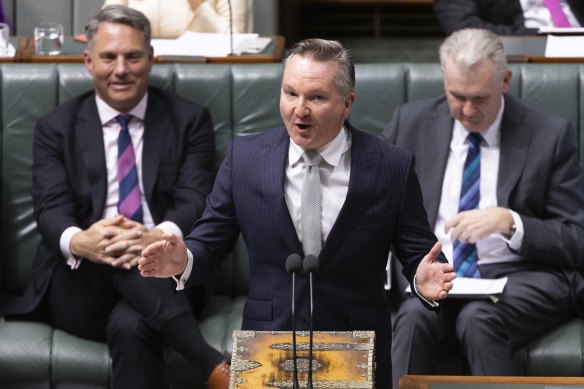
Dale Henderson, the chief executive of Lithium producer Pilbara Minerals, said the budget measures would support the growth of the critical minerals industry, which presented a “huge opportunity” for Australia.
“The country is competing in a global race for investment and market share,” he said.

Climate Change and Energy Minister Chris Bowen in parliament on Wednesday.Credit: Alex Ellinghausen
Arafura Rare Earths boss Darryl Cuzzubbo said spurring downstream manufacturing would “keep the vast majority of value-add, jobs and skills in Australia”, while MinRes, a mining services provider and lithium producer, said downstream projects “won’t happen in Australia without the government coming to the plate”.
“While MinRes doesn’t benefit directly from the production tax incentive, this is sensible policy that will make Australia more competitive,” a company spokesman said.
The budget also delivered a boost to the nascent green hydrogen industry, including a $2 per kilogram tax credit for production of the fuel.
Loading
Green hydrogen is considered a promising future fuel due to its potential to displace gas and help decarbonise processes that cannot be simply electrified. However, it remains prohibitively expensive to make and is not yet viable at scale, with most of today’s hydrogen still made using fossil fuels.
“Australia is back in the global green hydrogen race with this budget,” said Joanna Kay, the head of Zero Carbon Hydrogen Australia.
“Our 100-plus-strong members have long been calling for action by the Australian government to back in the green hydrogen industry, as the net-zero fuel of the future.”
Powerful investors on Wednesday threw support behind the federal budget’s green energy focus, which would boost Australia’s chances of staying competitive in the hastening global race for green energy capital.
The Investor Group on Climate Change, a coalition of 104 global and local institutional investors including AustralianSuper, Cbus, Fidelity, BlackRock and Vanguard, described the support package as a “down payment in Australia becoming a magnet for capital”.
“Our investors are lining up around the world to invest in green hydrogen, critical minerals and renewables,” said investor group managing director Erwin Jackson.
“But they can’t do that until they deliver the best returns for your retirement savings and as a result, they’re currently investing in the United States, in Europe and other jurisdictions because of the policy subsidies that they’re providing.”
Debby Blakey, the head of superannuation giant HESTA, said the focus on commodities vital to the energy shift was a crucial step towards scaling up mining operations, strengthening supply chains and helping Australia meet its net-zero emissions target.
Loading
Tony Wood, energy director at the independent Grattan Institute think tank, said the government should help industry develop projects “where we have got a competitive advantage”, such as green hydrogen fuelled by Australia’s abundant renewable resources.
However, he cautioned that such a scheme could wind up wasting public funds unless it targeted the most prospective projects with “strong and clear governance” over selection criteria and funding arrangements.
“We’ve recently had a series of announcements about alumina and graphite and quantum computing, which don’t appear to have gone through a very robust process,” Wood said.









 Add Category
Add Category